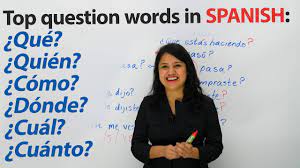Do you ever wonder what ‘who’ means in Spanish?
Well, in this article, we’ll break it down for you!
We’ll explore the different forms of ‘who’ in Spanish, how to use it to refer to people, animals, and things, as well as common mistakes to avoid.
So, if you’re ready to dive into the fascinating world of ‘who’ in Spanish, keep reading!
The Meaning of ‘Who’ in Spanish
Do you understand who in Spanish?
In Spanish, the word for ‘who’ is ‘quién’. It’s used to refer to a person or to ask about someone’s identity.
For example, if you want to ask someone’s name, you’d say ‘¿Quién eres?’ which means ‘Who are you?’
It’s important to note that ‘quién’ can also be used in plural form, ‘quiénes’, when referring to a group of people.
For instance, if you want to ask a group of people who they are, you’d say ‘¿Quiénes son ustedes?’ which translates to ‘Who are you all?’
Remember that ‘quién’ is a question word, so it’s typically used at the beginning of a sentence to inquire about someone’s identity.
Different Forms of ‘Who’ in Spanish
In Spanish, ‘quién’ is used to refer to ‘who’ when asking about a singular person. For example, ‘¿Quién es tu amigo?’ means ‘Who is your friend?’
On the other hand, ‘quiénes’ is the plural form of ‘quién’ and is used when asking about multiple people. For instance, ‘¿Quiénes son tus amigos?’ translates to ‘Who are your friends?’
Lastly, ‘quién es’ is a combination of ‘quién’ and ‘es’, which means ‘is’. It’s used to ask about the identity of a singular person. For example, ‘¿Quién es él?’ means ‘Who is he?’
These different forms of ‘who’ in Spanish help us ask questions about individuals and groups of people.
Using ‘Who’ to Refer to People in Spanish
When referring to people in Spanish, the word ‘who’ can be translated as ‘quién’ or ‘quienes’. ‘Quién’ is used when referring to a singular person.
‘Quienes’ is used when referring to multiple people.
These pronouns are used to ask questions or to introduce information about someone in a sentence.
Subject Pronouns in Spanish
You’ll learn about subject pronouns in Spanish during today’s lesson. Subject pronouns are used to replace the noun or noun phrase that acts as the subject of a sentence.
In Spanish, subject pronouns are often omitted because the verb itself indicates the subject. However, subject pronouns can be used for emphasis or clarification.
The subject pronouns in Spanish are:
- yo (I)
- tú (you)
- él (he)
- ella (she)
- usted (you formal)
- nosotros/nosotras (we)
- vosotros/vosotras (you all)
- ellos/ellas (they)
- ustedes (you all formal)
It’s important to note that the subject pronouns in Spanish have different forms depending on the gender and number of the noun they replace. So pay attention to these details as we go through the lesson.
Interrogative Pronouns in Spanish
Do you often wonder who’s the interrogative pronoun used to refer to people in Spanish? Well, wonder no more! The interrogative pronoun for people in Spanish is ‘quién’.
This pronoun is used when asking questions about specific individuals. For example, if you want to ask ‘Who is that?’ in Spanish, you’d say ‘¿Quién es esa persona?’
The great thing about ‘quién’ is that it can be used both as a subject and an object pronoun. So whether you’re asking about someone’s identity or asking who did something, ‘quién’ has got you covered.
Keep in mind that ‘quién’ has different forms depending on its function in the sentence, such as ‘quienes’ for plural subjects.
Using ‘Who’ to Refer to Animals or Things in Spanish
So you already know that in Spanish, ‘who’ is used to refer to people.
But did you know that ‘who’ can also be used to refer to animals or things? That’s right! In Spanish, ‘who’ can be used to ask about the identity or characteristics of animals or inanimate objects, just like how we use ‘who’ in English to refer to people.
It’s a handy way to personalize and humanize non-human entities in the language.
Who’ for Non-Humans
Can you believe that animals and even objects can be referred to as ‘who’ in Spanish? It may sound strange, but it’s true!
In Spanish, the word ‘quien’ is used to refer to both humans and non-humans. This concept might be difficult to grasp for those learning the language, as we usually use ‘who’ exclusively for humans in English.
However, in Spanish, the idea is that all beings, whether they’re humans, animals, or objects, have a certain level of importance and individuality. This linguistic nuance reflects the cultural perspective of valuing and respecting all forms of life.
Animals as ‘who’?
Have you ever wondered why animals are referred to as ‘who’ in Spanish, and how this linguistic choice reflects cultural perspectives on the value of all beings?
In Spanish, animals are often referred to using the pronoun ‘quien’, which means ‘who’ in English. This may seem strange to English speakers, who typically use ‘what’ to refer to animals. However, this linguistic choice reflects a cultural perspective that views animals as sentient beings with their own identity and worth.
By using ‘who’ instead of ‘what’, Spanish speakers acknowledge the individuality and agency of animals. It implies a recognition that animals have thoughts, feelings, and rights, and should be treated with respect and dignity.
This linguistic nuance reflects a cultural belief in the inherent value of all beings, regardless of their species.
Questions With ‘Who’ in Spanish
Do you know who’s the person in charge of the project? It’s an important question because knowing who’s leading the project can provide clarity and direction.
In many organizations, the person in charge is typically the project manager. They’re responsible for overseeing the project from start to finish, ensuring that all tasks are completed on time and within budget. The project manager also acts as a liaison between team members and stakeholders, communicating progress and addressing any issues that may arise.
Their role requires strong leadership skills, effective communication, and the ability to problem-solve. So, if you’re unsure who’s in charge of the project, it’s essential to find out to ensure that everything runs smoothly and successfully.
Indirect Object Pronouns With ‘Who’ in Spanish
Could you please clarify who you’re referring to with the indirect object pronoun ‘who’ in Spanish?
It’s important to understand that in Spanish, the indirect object pronoun ‘who’ can refer to a person or people.
When using ‘who’ as an indirect object pronoun, it’s typically translated as ‘a quién’ or ‘a quiénes’.
For example, if you want to say ‘I gave the book to María’, you’d say ‘Le di el libro a María’ in Spanish. Here, ‘who’ is replaced by ‘a quién’, indicating that María is the person to whom the book was given.
It’s crucial to be aware of the context in order to accurately determine who’s being referred to with the indirect object pronoun ‘who’ in Spanish.
Common Mistakes and Tips for Using ‘Who’ in Spanish
You should avoid making the common mistake of using ‘who’ as a direct object pronoun in Spanish. In Spanish, the correct direct object pronoun for ‘who’ is ‘a quien.’ Using ‘who’ as a direct object pronoun is a common error, especially for English speakers learning Spanish.
It’s important to remember that in Spanish, direct object pronouns must agree in gender and number with the noun they replace. So instead of saying ‘I saw who,’ you should say ‘Vi a quien.’ This may seem confusing at first, but with practice, you’ll become more comfortable using ‘a quien’ as a direct object pronoun.
Keep in mind that using the correct pronoun will improve your Spanish fluency and help you avoid common mistakes.
Conclusion
In conclusion, understanding how to use ‘who’ in Spanish is essential for effective communication. Whether referring to people, animals, or things, knowing the different forms and contexts in which ‘who’ is used is important.
Additionally, mastering questions and indirect object pronouns with ‘who’ can further enhance your language skills. By avoiding common mistakes and practicing regularly, you can confidently use ‘who’ in Spanish and improve your overall fluency.


